If you’re thinking about breast augmentation surgery, you’re not alone. This cosmetic procedure remains a popular one worldwide and shows no signs of slowing down. In fact, the most recent stats show that nearly 20,000 Australian women had breast augmentation surgery performed in 2016. According to Dr. Bernard Beldholm one of the most common questions he receives from patients interested in getting breast implants is: “How many CCs are equal to a cup?” As a general rule of thumb, it takes about 150 to 200 CCs to increase a woman’s size by one cup. As you might guess, the higher the number, the larger the implant.
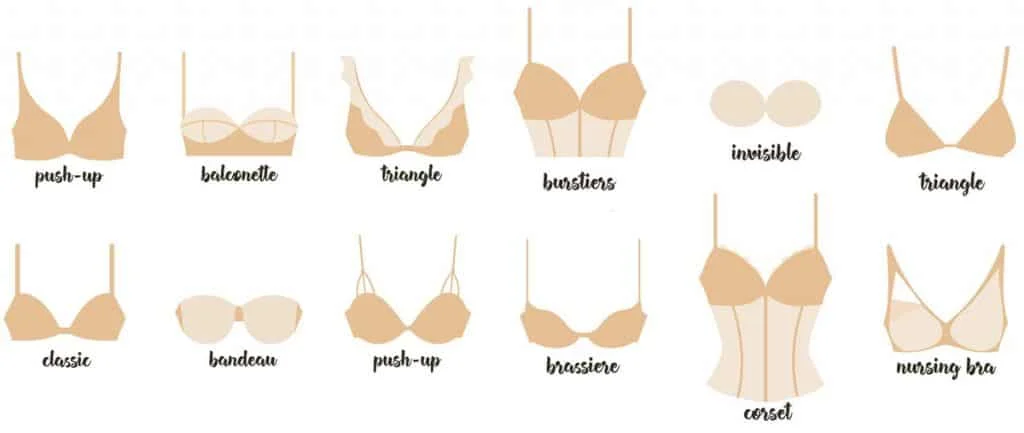
Content of this article
- Cup Size is Subjective, Not Standard
- A Brief History on Cup Size
- Signs You’re Wearing the Wrong Bra Size
- The Perfect Fit: Finding Your Band Size
- The Perfect Fit: Finding the Right Cup Size
- Understanding “Sister Sizes”
- Bra Cup Size and Breast Implants: Do the Two Go Hand-in-Hand?
- Determining the Breast Implants Size Prior to Surgery
Cup Size is Subjective, Not Standard
But here’s where the problem comes into play. Just as shirts and pants sizes vary from company to company, bra cup sizes are also subjective. Unfortunately, there is no standardised method. That’s why women shouldn’t compare their desired breast size to the cup size of a bra. One woman might be a large A cup in one bra, a B cup in another, and a small C cup in a third one.
Coupled with the fact that many women don’t wear the correct size bra to begin with, cup size is not a good indicator of what a patient’s breast augmentation might look like following surgery. A patient’s version of what a D cup looks like may very well be different from what a surgeon envisions.
According to one consumer study, it’s estimated that almost 70% of Australian women are currently wearing the wrong size bra, and using a professional in-store fitter isn’t any guarantee of getting a well-fitting one either. An undercover operation conducted several years ago by consumer group CHOICE found that a large majority of bras chosen by professional fitters were 43 percent too small.
Because bra sizing can be confusing and downright frustrating, it’s impossible for surgeons to guarantee a specific cup size–since sizes vary per country and manufacturer. Doctor Beldholm uses very specific measuring techniques. We will talk about those measuring techniques further down in the article.
Download our guide: “How to Choose a Breast Implant”
A Brief History on Cup Size
Women have used a variety of garments to cover, restrain or ** the appearance of their breasts over the course of history. The first modern bra was patented by Christine Hardt, a German woman, in 1889. It wasn’t until 1929, however, that Maidenform Brassiere Company debuted the cup system. A few years later, S H Camp & Co first advertised the cup lettering system in Corset and Underwear Review. This new bra measuring system correlated the ‘size and pendulousness’ of the breasts to just four letters– A, B, C and D. Adjustable bands and eye hooks were also added to these new bras. Before this, bras came in only small, medium or large sizes. Numbers for bra sizes were eventually introduced some time after World War II. Fast forward to today, and women now have tons of bra options as well as more bra sizes to choose from.
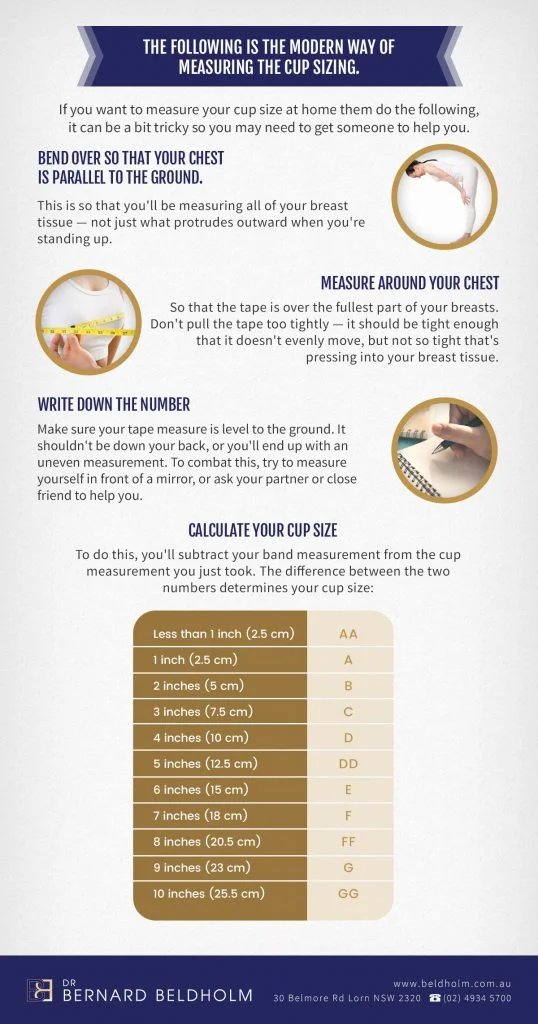
Signs You’re Wearing the Wrong Bra Size
Despite the increase in choices, we dare say it’s made it even harder for women to pick the ** bra size. Doctor Beldholm has seen many patients who’ve come into his practice wearing the wrong-sized bras. Some patients wear bras that have a lot of padding, dramatically changing the cup size. Some women post pregnancy have significant ** and wear bras that have cup sizes that are either too big because they are more ** with this or too small because they want to push up the breast tissue to create upper pole fullness. For patients interested in breast reduction surgery, they often wear bras that do not correctly reveal their true cup size.
Discomfort should be the first red flag that you are wearing the wrong bra size. But those aren’t the only signs to look for. Here are a few other clues that the bra you are wearing isn’t right for you:
1. Your bra straps won’t stay in place
If your bra straps keep falling down, consider tightening the straps. However, don’t tighten the straps to the point that they are digging into your skin. If your straps keep slipping even after you adjust them, consider going down a band size.
2. Your breasts spill over the top, bottom and sides of the bra
If your breasts can fit into the cups of your bra **, it’s time to consider going up a larger size.
3. The center of your bra is lifted off your chest
The middle piece between the cups should sit flat on your rib cage. If there’s any space, your cup size is too small, and you should consider going up a size.
4. You have the “infamous” back bulge after putting on your bra
No, you didn’t instantly grown extra back fat after putting on your bra. It’s likely caused by your band size being too small or not wide enough. If that’s the case, consider going up a size.
5. Your cups wrinkle ** or appear baggy
Usually this is a sign that you are wearing a bra cup that is just too big for you. Considering going down a size.
6. Your breasts easily fall out of your bra
Your bra should easily secure your breasts and hold them in place. If they don’t, this could be a sign that your cup size is too large and you need to go down a size.
7. You suffer from “boob sweat”
This could be a sign that you’re wearing a bra made from a smothering fabric or it could just contain way too much padding.
8. Your band won’t stay put in the back.
The back of the bra should not ride up and the chest band should remain parallel to the floor when viewed from the back. The breasts should be supported primarily by the band around the rib cage. If it’s riding up in the back, it’s too big.
The ** Fit: Finding Your Band Size
When finding the bra that fits your shape and size, measurements need to carefully be taken for both the cup size and band size. Measuring your band size should be pretty straightforward, right? Wrong! Just as cup size varies from manufacturer so does band size. For example, Victoria’s Secret suggests measuring above the breasts to determine band size:
- Stand in front of a large mirror wearing a non-padded bra.
- Wrap a soft measuring tape around your back at band level, under each arm and around the front.
- Measure just above your bust, right about where the straps meet the top of the cup.
- If your measurement includes an odd number, simply round down to the nearest even number.
Meanwhile, most other bra manufacturers that we’ve looked into such as Berlei and Elle Macpherson recommend taking measuring under the breasts:
- Run a tape measure all the way around your body just underneath your breasts and take a measurement in centimeters (UK and Australia). If you are planning to get a bra from the US then inches would be a better measure.
- Make sure the tape measure is horizontal and fairly snug. Your arms should be down.
- Make sure you are breathing normally when doing so and that your chest is relaxed
The confusion over which method to use to obtain your band measurement does not stop there, unfortunately. Once you obtained your measurement, there are multiple ways of using this measurement to actually obtain a band size! Yes, we know. This is rather time consuming–not to mention a bit annoying. There are 4 different methods for matching the actual band measure with a bra size:
1. Underbust +0 Method
The measurement in inches is then rounded to the nearest even number for the band size.
2. Underbust +4 Method
If the measurement is even, 4 (10 centimeters) is added to calculate the band size. If it is odd, 5 (12.5 cm) is added.
3. Sizing Chart Method
Start with the measurement taken underneath the bust. A sizing chart or calculator then uses this measurement to determine the band size.
4. Under Arm/Upper Bust Method
This is the Victoria’s Secret way of measuring. Because band sizes are most commonly manufactured in even numbers, the wearer must round to the closest even number.
It’s important to mention that Australia and New Zealand cup and band sizes are in metric increases of 2 cm per cup. This is similar to many European brands.
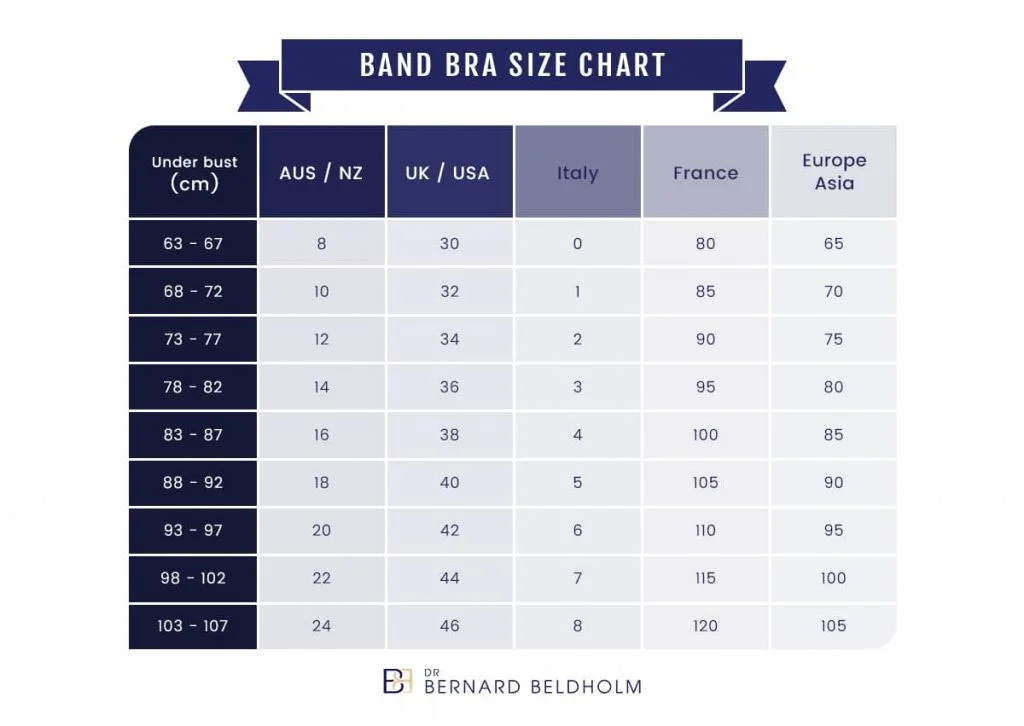
This chart shows the under bust measure and the corresponding sizing. As you can see, there is a wide range of different terminology and numbers.
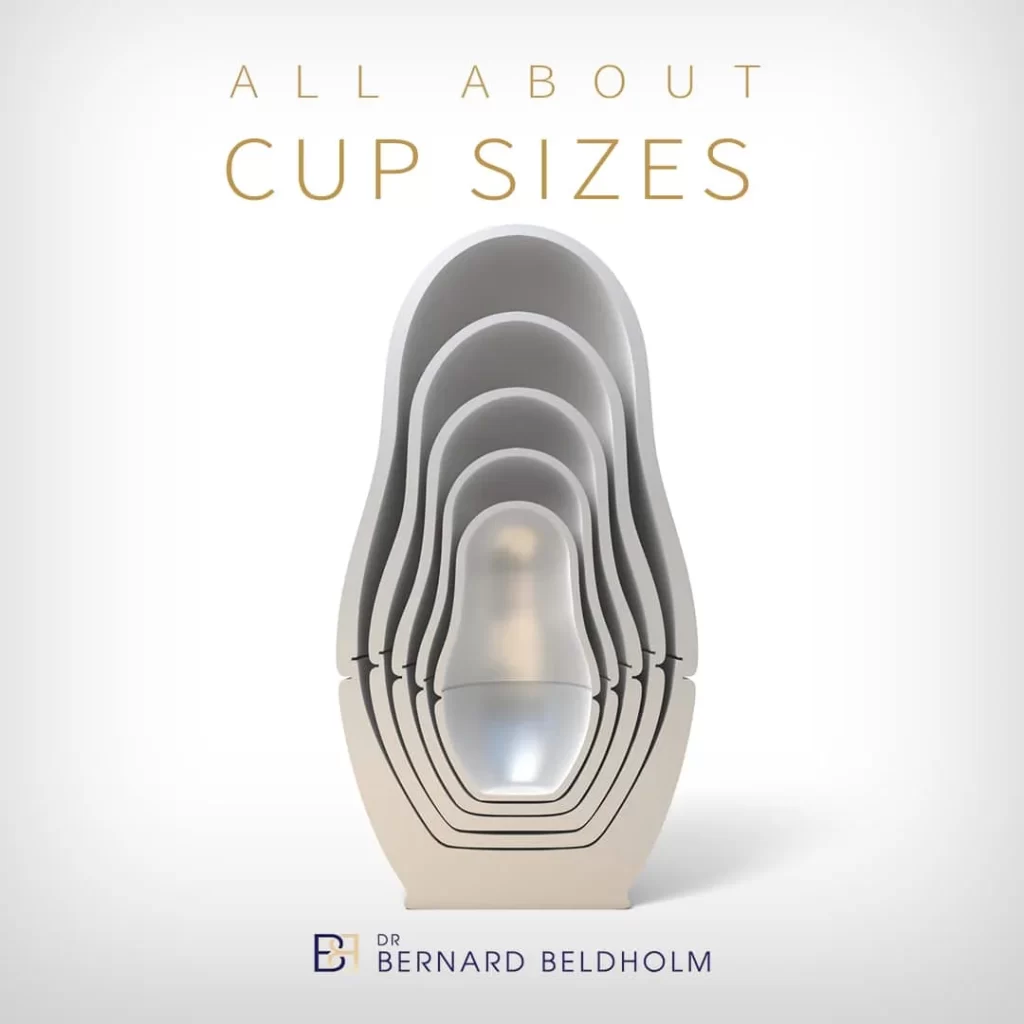
The ** Fit: Finding the Right Cup Size
It is important to know that cup size is proportional to your band size. The bigger the band size the bigger the volume is in the cup. It is also important to understand that the great variation in measuring techniques for bra brands can produce a wide range of different cup sizes.
As with the band size there are many different ways to measure the cup size (as we’ve already mentioned above). However the more common way is to:
- Keep the tape around your back at band level
- Measure at the fullest part of your bust
- Make sure the tape isn’t too tight by taking a full breath in and out, allowing the tape to slide to its most ** (yet snug) position.
This method assumes that you are already in a correct fitted bra, without padding. If you are not wearing a bra when doing the measure then it only works if you do not have ** breasts. Some bra fitters recommend that you bend over with the breasts facing the floor and then do the measure across the widest section of your breasts. Usually the nipple area.
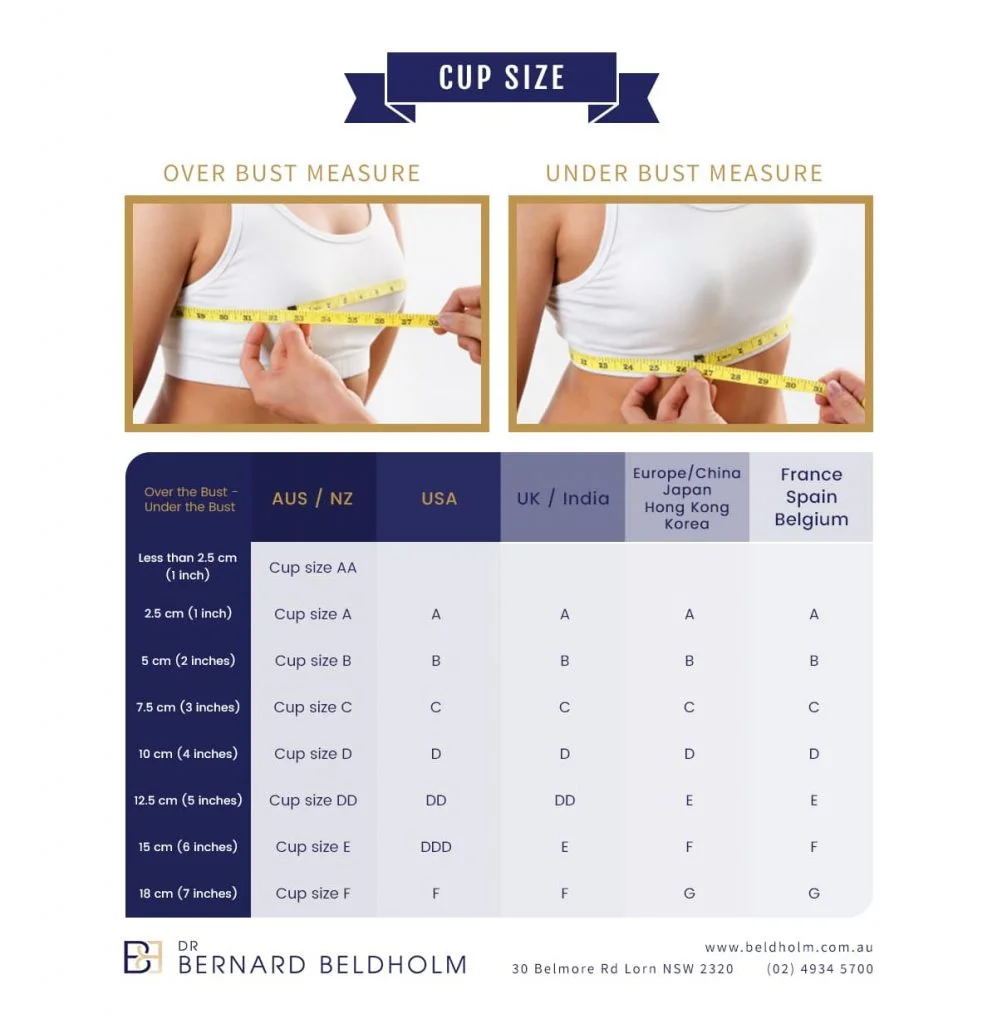
The difference between the underbra and the overbust measure is then the cup size. If you are lucky, you may get a cup size that actually fits you! However, you should try the bra on as even the most careful measurements will not be **.
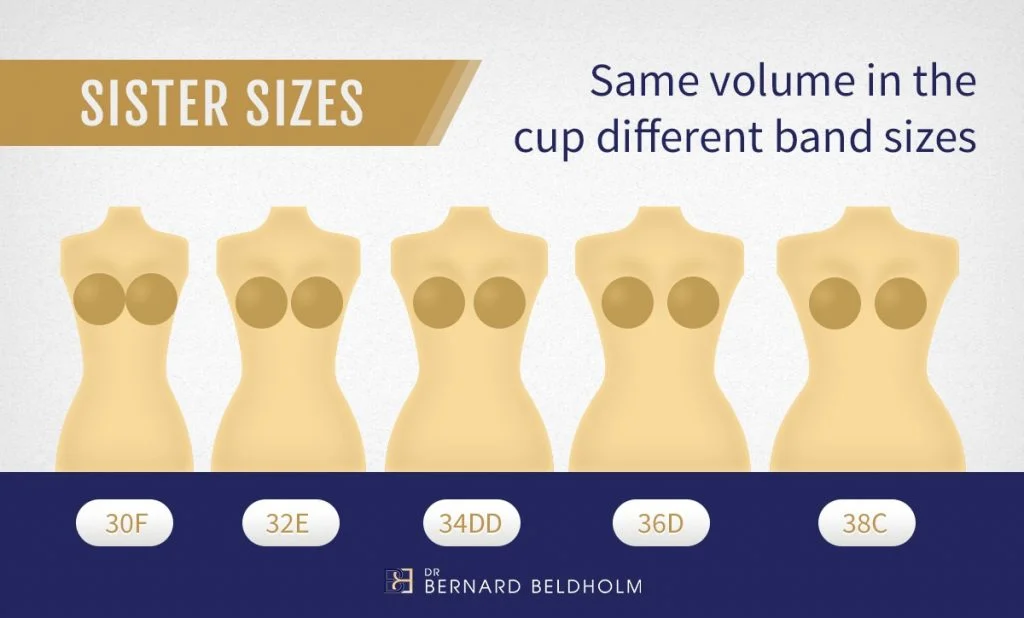
Understanding “Sister Sizes”
These are simply alternate sizes where the cup volume stays the same even though the band size and cup letter changes. If you’re wondering what “sister size” would work for you, it’s pretty **. If you go one band size down, you’d go one cup size up. For example, if you wear a 34C, your Sister Size DOWN would be 32D. If you go one band size up, then you go one cup size down. For example, if you wear a 34C, your Sister Size UP would be 36B.
Bra Cup Size and Breast Implants: Do the Two Go Hand-in-Hand?
Up to this point, you’ve probably learned way more than you ever thought imaginable about obtaining a well-fitting bra and how not all sizes are created equal. Now you’re likely wondering, “What does it all mean when it comes to breast augmentation and trying to decide my cup size?” The answer is quite **. Nothing! Breast implant size has absolutely nothing to do with bra cup size. Unfortunately, though, many patients become fixated on the cup size. The size of their implants (rather than desired bra size) should complement their figure in a way that appeals to the patient.

Determining the Breast Implants Size Prior to Surgery
1. Suprasternal to Nipple
This measure is from the top of the sternum to the nipple. It helps identify where on the chest wall that the breasts are and how ** they are.
2. Midline to Nipple
This measure will help decide the beast breast implants shape for you.
3. Inframammary Fold to Nipple
This is another very helpful measure to establish what shape of implants is the beast for you
4. Base Width
This measure is among the most important measure that we can do. It will determine what implants are able to fit your chest wall and the exact diameter that this implant will need to have.

5. Upper Pole Thickness
This is how thick the breast tissue is in the upper pole of the breast. It will determine if the implant needs to go under or above the muscle.
6. Position of the nipple in relation to the breast fold
This is a very important measure to see if you need a breast lift or not. If the nipple sits below your breast fold than you will most likely need a breast lift. If it sits on or above, then it is unlikely that you will need a breast lift.
7. Under breast measure and over breast measure
This measure determines your cup size and band size. It helps us with ordering the appropriate surgical bra as well as determine the cup size that an implant will take the patient to. To determine the size of the band, we use the Victoria’s Secret measuring method.
Book your appointment online now
REFERENCES
- King NM; Lovric V; Parr WCH; Walsh WR; Moradi P, “What Is the Standard Volume to Increase a Cup Size for Breast Augmentation Surgery? A Novel Three-Dimensional Computed Tomographic Approach.” Plastic & Reconstructive Surgery. 139(5):1084-1089, 2017 May.
- Bradley P; Glicksman C, “The Standardization of Bra Cup Measurements Redefining Bra Sizing Language” Clin Plastic Surg 42 (2015) 405–411




